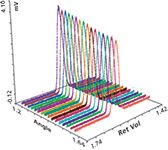Characterizing Polysaccharide Structure with SEC–MALS and Intrinsic Viscosity Measurements
The Application Notebook
Malvern Instruments Ltd.
The physical properties of polymers and polysaccharides depend strongly on their molecular properties, the most important of which are the molecular weight and molecular weight distribution, and the molecular size and structure. Gel permeation chromatography (GPC), also called size-exclusion chromatography (SEC), is the most commonly used tool for assessing these parameters, and is enhanced by coupling it to light scattering and viscometer detectors. In particular, the concurrent measurement of Rg using multi-angle light scattering (MALS) and intrinsic viscosity offers exceptional insight into the structure of synthetic and natural polymer molecules.
In this application note, molecular weight Rg and IV data are combined to study the structure of different polysaccharides.

Figure 1: Chromatogram showing RI (red), LS (90°) (orange), and IV (blue) detector responses for pectin.
Materials and Methods
Analysis was carried out using a Viscotek TDAmax system with SEC-MALS 20 detector. Viscotek A6000M columns were used and all samples were dissolved overnight in the mobile phase to a concentration of 0.5–3 mg/mL, with an injection volume of 100 µL.

Figure 2: Overlay of SECâMALS detector signals for pectin at all angles.
Results
Figure 1 shows an example chromatogram of pectin including the RI, LS (90°), and IV detectors, and Figure 2 shows the angular data from the SEC-MALS 20 detector. A slight angular dependence can be seen across the different angles, allowing Rg to be measured for this sample.
The results are also plotted on a Mark-Houwink (IV vs. MW) plot for a visual comparison. This allows comparison of different samples and is ideally suited to the study of branching and other structural changes.

Figure 3: Mark-Houwink plot comparing pectin with other polysaccharides.
Discussion
The Mark-Houwink plot shows that pectin is the highest and therefore the least dense molecule of those under investigation. As a comparison, gum arabic, which has the highest molecular weight, is the lowest on the plot, indicating that it is the smallest or most dense of the different samples.
In summary, the molecular weight, size, and intrinsic viscosity of pectin was measured using the Viscotek TDA and SEC-MALS 20 systems and compared with a selection of other polysaccharides. The differences in molecular structures between the different polysaccharides are very clear and easily observed using the Mark-Houwink plot.
Reference
(1) Characterizing polysaccharide structure with SEC-MALS and intrinsic viscosity measurements, Malvern Instruments application note, www.malvern.com/MRK1929
Malvern Instruments Ltd.
Enigma Business Park, Grovewood Road, Malvern, UK
Tel: +44 (0) 1684 892456
E-mail: salesinfo@malvern.com
Website: www.malvern.com


SEC-MALS of Antibody Therapeutics—A Robust Method for In-Depth Sample Characterization
June 1st 2022Monoclonal antibodies (mAbs) are effective therapeutics for cancers, auto-immune diseases, viral infections, and other diseases. Recent developments in antibody therapeutics aim to add more specific binding regions (bi- and multi-specificity) to increase their effectiveness and/or to downsize the molecule to the specific binding regions (for example, scFv or Fab fragment) to achieve better penetration of the tissue. As the molecule gets more complex, the possible high and low molecular weight (H/LMW) impurities become more complex, too. In order to accurately analyze the various species, more advanced detection than ultraviolet (UV) is required to characterize a mAb sample.

.png&w=3840&q=75)

.png&w=3840&q=75)



.png&w=3840&q=75)



.png&w=3840&q=75)








